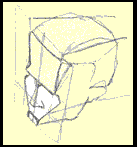A
Preview Of The Lessons In Part II:
Depth of detail
that you'll finally recognize
in every person you see and draw
In Lesson 10 you'll start off with the easiest feature: the ear. You'll revisit and re-focus what you've learned in Part I. You'll combine those basic drawing skills and apply them. You'll apply pure and modified contour to your ear-drawing exercises; then you'll apply what you've learned from the negative space and positive form lessons. You'll have a "gestalt" drawing left and right ears when you apply "vase-face" techniques to creating them. By applying what you've just learned in the foundation lessons you'll build expertise and confidence, reabsorbing them, etching them deeper into your drawing repertoire as you explore each of the three drawable parts of the ear. Sound like a foregin language right now? It'll be second nature after you work your way through the lessons.
Build an onboard library in
your brain you
can access in an instant
You'll start simple and dig deeper into more and more subtle and intricate, relevant and drawable anatomy until you build an onboard library in your brain you can instantly access whenever you size up your drawing subjects.You'll know exactly what to look for.
In Lessons 11, 12 and 13 you'll repeat the process for all the rest of the facial features. You'll go right through the list of foundation skills as you draw the nose with it's three pair of cartilage, the eye with it's globe, iris, lids, lashes and highlights. You'll internalize the structure of mouth and it's underlying bony architecture, then extending the same to the lips and teeth.
Then, in Lesson 14. After you've had some time to practice all those features and get repetition using the foundation skills, you need a place to draw all those amazing features. Here you'll embark on the shapes of the head.

Building the Human Head "Miter Box" and "Mr. Average Face"
You'll see how to apply perspective to drawing the head, how to build a "miter box" so you can grasp the three dimensionality of the head. Learning this you'll be able to figure out why certain drawings just "don't look right". With this method you'll have a sure fire approach to grasp the volumes of the head every time.
"Mr. Average Face". All this leads up to the "Mr. Average Face" model - the one you need to internalize in your brain like a map so when you look at anyone else's face, you can pinpoint, you can "put your pencil on" what makes this person so unique, what makes them look like who they are. And that's the most amazing thing - being able to see and appreciate the unique beauty in any one.
The human head is in my opinion the most incredible example of natural architecture in the living world. All of creation is amazing, but the human face, head, and body have to be three of Nature's pinnacles. That's my opinion.
We break it down
Like in Lesson 13 - drawing the eye - you'll find over 60 illustration-filled printable pages. Why 60 pages on eyes alone? Not to overwhelm you, but because we spoon feed you. We break all the features down into pieces that are so basic and understandable you'll whip right through them - and remember them. And that's the approach you'll see as you work your way through all of the features. Giving you the foundation you need to see the most common, drawable features and shapes in every human being.
And all the time doing exactly what artists do: building upon your knowledge and application of the five foundation skills of drawing, i.e. learning to stay in your artistic "right brain".
Kasbohm & Company's
YouCanDraw.com
1351 Hampshire Ave. S.,
#127
St Louis Park, MN, 55435
© Copyright
1997-Present
All Rights Reserved